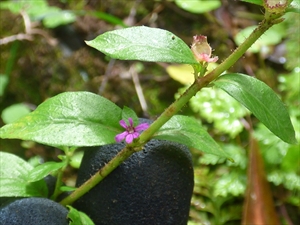Colombian waxweed. It is also known as tarweed, and Colombian cuphea.
Pacific Pests, Pathogens and Weeds - Online edition
Pacific Pests, Pathogens & Weeds
Colombian waxweed (488)
Cuphea carthagenensis. It is a member of the Lythraceae.
Asia, Africa (restricted), North, South and Central America., the Caribbean, Oceania. It is recorded in Australia, American Samoa. Federated States of Micronesia, Fiji. French Polynesia, New Caledonia, Northern Mariana Islands, Samoa, Tonga, and Vanuatu. Considered to be native in tropical America and the Caribbean.
An important invasive weed producing large numbers of viable seeds, rapidly growing and forming dense stands in pastures, cultivated land, wetlands, on the banks of streams and rivers, and roadsides. Pastures are particularly at risk if they are overgrazed and then become flooded. In general, a weed of seasonally-waterlogged soils, open to the sun. Of limited occurrence in native vegetation.
An annual herb, upright, growing to 60 cm with red or green slender stems covered in dense sticky hairs (Photo 1). Leaves, 10-60 mm long, 2-25 mm wide, oval with pointed tips, in pairs on short stalks along the stem (Photo 2). Leaves also have sticky hairs. Flowers, single or in clusters at leaf forks or ends of branches; each flower has six purple-pink petals, a green or reddish tube at the base, enclosing a tiny capsule containing the seeds, eventually swelling and splitting when ripe to release 4-8 green, later brown or black, seeds (Photo 3).
Spread is by seeds that are shed into flood water, or moved by livestock and/or by machinery. The waxy sticky coating of the seeds assists their dispersal. It has also been considered an ornamental, later escaping from gardens into cultivation.
Colombian waxweed can out-compete common pasture species leading to lower stocking rates. Cattle do not like eating it although there are no reports of it being poisonous. In Indonesia, it is one of the top ten weeds and a major problem in maize; in Vanuatu, it is a serious pest of coconut plantations; in Fiji, a weed of taro; and in Australia, a weed of pastures.
Colombian waxweed is thought to have medicinal properties and is often taken from the wild, and sold in local markets. It is used for heart conditions, anaemia, stomach aches, and worm parasites. The plant is often grown as an ornamental, especially in tropical and subtropical climates. In temperate countries, it may have potential for its oil, rich in medium-length fatty acids.
BIOSECURITY
Once established, Colombian waxweed is difficult to control. Countries not yet infested (especially in Africa and Oceania) should consider all likely pathways for entry, and apply quarantine measures accordingly. Particular attention should be given to the stickiness of the seeds which assists their dispersal.
BIOLOGICAL CONTROL
Not a method recommended for Colombian waxweed.
CULTURAL CONTROL
- Physical & Mechanical:
- Pull-out plants by hand, bagging and disposing of them safely, preventing the release of seed from pulled plants.
- Slashing and mowing are not recommended; it may help to spread the sticky seed. Also, the weed tolerates being cut short better than more useful pasture species.
- Hygiene:
- Treat vehicles and farm machinery. If moving from areas where the weed occurs to those weed-free, wash to remove soil. This is equally important if the machinery is being imported into a country or moved within a country.
CHEMICAL CONTROL
Use herbicides at the start of flowering. Several herbicides are registered in Australia, including: fluroxypyr; glyphosate; triclopyr + picloram; triclopyr + picloram + aminopyralid; 2,4-D + picloram; 2,4-D + picloram + aminopyralid.
--------------------
Note, EU approval to use glyphosate ends in December 2022; its use after that date is under discussion.
____________________
When using a pesticide, always wear protective clothing and follow the instructions on the product label, such as dosage, timing of application, and pre-harvest interval. Recommendations will vary with the crop and system of cultivation. Expert advice on the most appropriate herbicides to use should always be sought from local agricultural authorities.
AUTHOR Grahame Jackson
Information from Colombian waxweed (Cuphea carthagenensis) (2011) Your alert to new and emerging threats. technigro. Australia. (http://www.technigro.com.au/wp-content/uploads/2016/12/11-Colombian-Waxweed.pdf); and Fern K, et al. (2014) Useful Tropical Plants Database. (http://tropical.theferns.info/viewtropical.php?id=Cuphea+carthagenensis); and CABI (2015) Cuphea cathagenensis (Colonian weed). Invasive Species Compendium. (https://www.cabi.org/isc/datasheet/113690); and from Jennings N (2016) Controlling Colombian waxweed (Cyphea carthagenensis) in pastures. FactSheet. Local Land Services North Coast. NSW. (https://northcoast.lls.nsw.gov.au/__data/assets/pdf_file/0008/685385/Factsheet-Colombian-waxweed.pdf). Photo 1 Karan A. Rawlins, University of Georgia, Bugwood.org. Photos 2-3 Forest & Kim Starr, Starr Environmental (Flikr). (http://www.starrenvironmental.com/images/search/?q=Cuphea+carthagenensis).
Produced with support from the Australian Centre for International Agricultural Research under project HORT/2016/185: Responding to emerging pest and disease threats to horticulture in the Pacific islands, implemented by the University of Queensland and the Secretariat of the Pacific Community.






